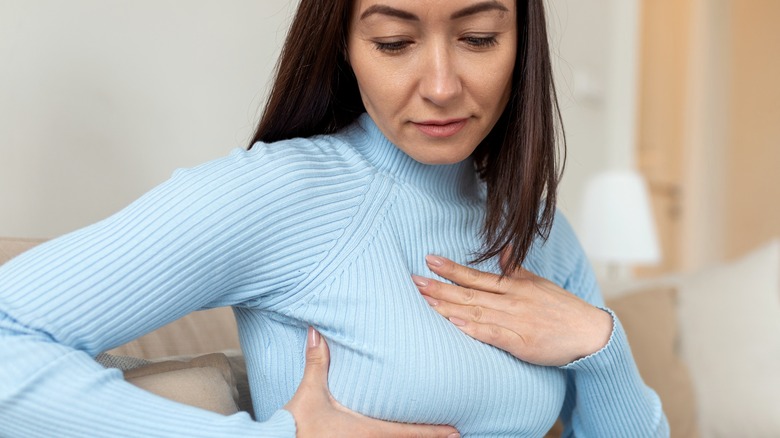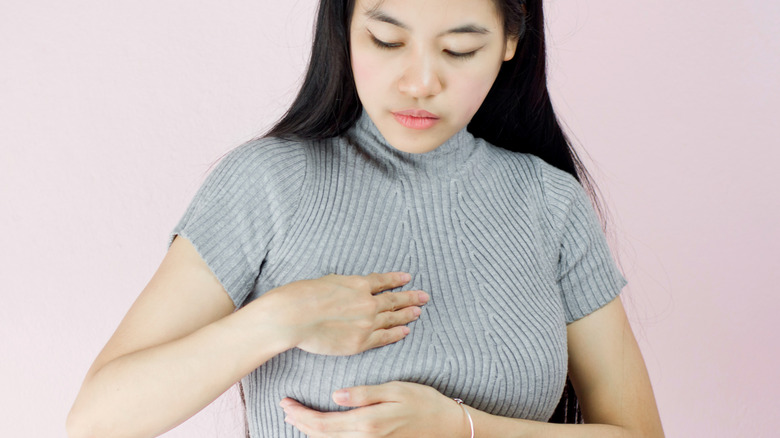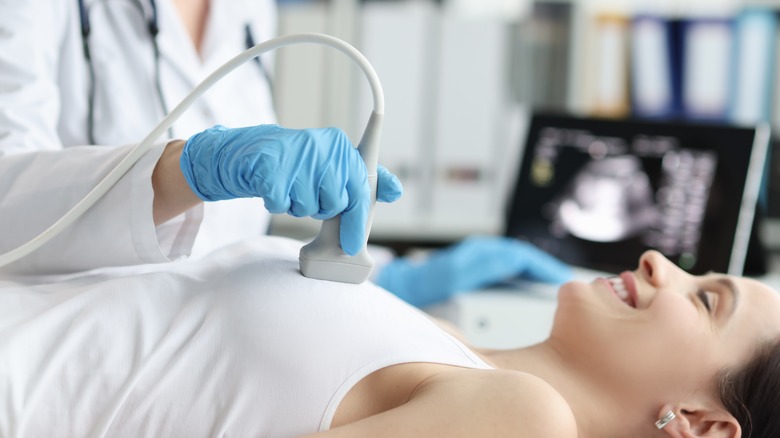What Does A Lump In Your Breast Really Feel Like?
The most typical cancer in women in the United States is breast cancer, a disease that develops in the cells of the breasts, per the Mayo Clinic. While it happens in both men and women, it's far more prevalent in women. Thanks to earlier identification and improved knowledge of the illness, breast cancer survival rates have risen recently and the number of fatalities linked to the disease has been falling. Because of this, it's crucial to know the state of your breasts by touch and feel in order to identify and treat abnormalities in your breasts.
The most common symptom of breast cancer, per the American Cancer Society, is when you feel a lump or mass in your breast. A breast tumor can either be soft or hard, round or edgy in shape, painful or painless. Usually, not all breast lumps are malignant and should be examined by a medical professional for accurate diagnosis. However, you can perform a breast self-exam at home to get a sense of how your breasts look and check for lumps.
What breast lump feels like
Per The Medical Group of South Florida, cancerous breast lumps can also vary in size. A lump must be one centimeter in size, roughly the size of a lima bean, before a person can sense it. For some people, a lump can be as big as a golf ball. The size of the lump, however, is determined by its location in the breast and the total size of the breast. Breast lumps and tumors are firmer and more rubbery than the rest of your breast tissue, and typically uneven in form. Some breast lumps are also movable within the breast, while others are attached to the breast tissue. Most breast lumps are painless, but a small percentage of women report feeling pain in their lumps. It is crucial to remember, however, that this experience varies from person to person.
"More often than not, breast lumps are harmless," says Dr. Jitesh Joshi to Houston Methodist. However, any lump could potentially be breast cancer, and feeling it isn't enough to know if it's cancer. However, Dr. Joshi notes that there are several changes in the look of your breast that give a lump reason for concern. Changes in the skin above the lump, changes in the shape or nipples or fluid discharge, and shifts in the size of the lump are all signs. Having a family history of breast cancer raises the likelihood that the lump is malignant.
Types of breast lumps
Most breast lumps might feel the same, but they can be universally different in nature. According to Everyday Health, 80% to 85% of all breast lumps are benign, meaning they are not life-threatening. Some benign breast lumps go away on their own, while others can be removed by way of surgery, fluid drainage, and antibiotic medication. The two most frequent causes of benign single breast lumps are cysts, which are frequently seen in women who are approaching menopause, and fibroadenomas, which are commonly seen in women in their 20s and 30s.
Malignant breast tumors, on the other hand, will continue to develop if not discovered and treated early, per Stony Brook Cancer Center. They will spread to nearby lymph nodes, where cancer cells will break free from the tumor and move to other parts of the body via the lymph system and circulation. At this time, the odds of successful treatment for malignant breast lumps are substantially reduced. Most malignant breast lumps develop in the upper, outer quadrant of the breast and extend toward the armpit. The nipple region is the site of around 18% of breast cancer tumors. Around 6% are found in the lower, inner quadrant, while around 11% are in the bottom quadrant.
Even if you have a basic understanding of breasts and can find a breast lump on your own, you should still see a doctor to determine if it is benign or malignant and to receive treatment recommendations.


